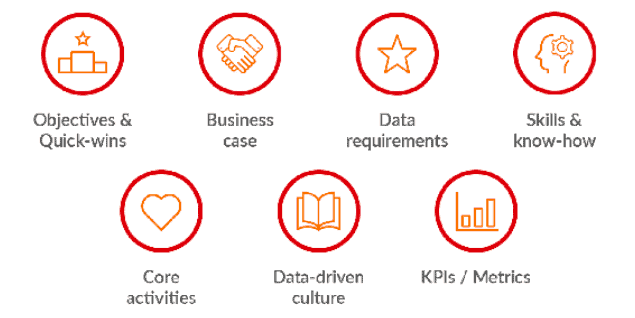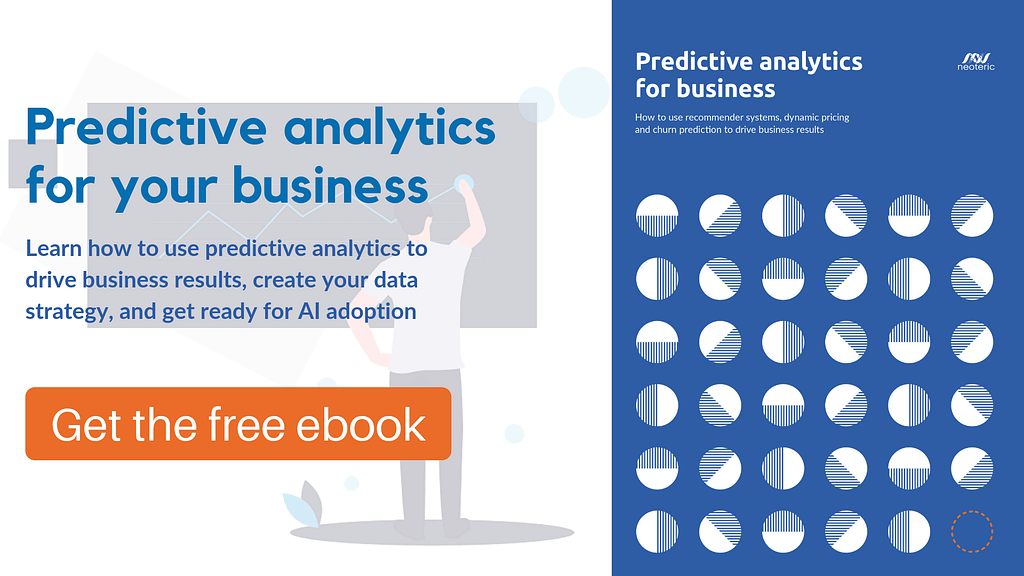Artificial intelligence adoption is tempting – with all the possibilities and success stories around, it’s surely crossed your mind to give it a shot, too. And it’s true that AI can solve various business problems and help organizations improve efficiency and increase revenue. However, AI implementation is not as simple as installing an app on your desktop – it’s a process that requires a strategic approach and the right preparation. AI is ready to become a part of any business – but is your organization ready for AI?
Ready or not, here’s AI
AI for business is still an emerging field – the technology is developing and maturing and is starting to become more accessible for more organizations. Early adopters of artificial intelligence have already tested a variety of AI tools in a wide spectrum of business use cases, making it easier for other companies to understand what the technology does and what results can be expected. It seems like AI is here to stay in the business world, and some experts state that organizations who fall behind on adopting it will never have a chance to catch up. We’re not there yet, there’s still time, and whatever AI technology you want to adopt there’s one thing you should never do: rush. Don’t rush with the decision (but also, don’t take too long!), and don’t rush with building the product.
How’s AI development different?
At the heart of an AI project is data. That’s different from the development of a web app because you can’t build an AI project on assumptions only. Naturally, web app development also requires preparation, market research, etc., but to use machine learning, you have to “teach” it about the area it’s going to support. For example, if you want to predict what other products Mrs. Jones will be interested in (so you can sell more), you need info on what Mrs. Jones likes (what she purchased, what she browsed, whether she reviewed any items), or what the product is (type, characteristics) to display similar items. Or, you can collect information on both the items and users. Then, when your model takes all this data, it will work out what patterns there are and generate a list of what Mrs. Jones is likely to be interested in. See, without the data – information on Mrs. Jones or the product – all you could do is guess. AI removes the guesswork from operations but only when it’s provided with the right data to generate results.
Read also: AI in product development
Am I ready for AI?
Let’s check. AI is attractive to many organizations, especially being such a buzzword and beating humans at more and more things. However, not every business needs to implement artificial intelligence, or there may be potential for AI, but they’re not ready yet – due to budget limitations, no know-how, insufficient understanding of AI technologies. Answer the questions below to find out whether you’re AI-ready. The list starts with general questions and moves on into more detailed ones. Be honest with yourself (you don’t have to show your answers to anyone if you don’t want to) and give yourself time to think about your answers.
Not every “No” will disqualify you from starting an AI project. Some of the “Nos” are easy to solve, some of them require preparation. The crucial aspects here are whether you know what problem you need to solve, whether you’ve decided to try AI (and all decision-makers support this decision), and there’s a budget for it.
Of course, it’s essential to have a team that will build the right model, but it doesn’t have to be an in-house team. You can hire a software development partner to build your solution and train your staff on how to work with it. Many AI experts recommend starting with an external data science team so you can start faster and don’t have to worry about recruiting the right people and having tasks for them to handle. When hiring an external company, you can expect them to show you case studies and testimonials from other clients to prove their expertise. Your AI partner should also be able to help you identify the appropriate business use case, assess your data, and match it with the right technology. Building the first AI project is far more than developing the model – and it all starts with business understanding.
The people factor matters
Artificial intelligence seems all about the smart machines – but it really is about people. People play a significant role at every step of the way: from identifying the use case and describing the process that can be optimized, through data cleaning and preparation, to communicating results and using the insights in their everyday work. Without people, the system won’t work. Data comes from people, people develop the model, and people use the findings. With the right approach (create your strategy, please!), you’ll prepare and train the people in your company to join forces and make it work. However, if you, as a leader, fail to communicate why AI is used and how it’s supposed to be used, and you exclude the staff from the entire process, a whole bunch of problems can occur. The team may receive a tool they don’t need, they may fail to use it right, they may be afraid of losing their jobs to machines, or unwilling to cooperate with AI, they may also not trust the results. In a series of articles about the mistakes of AI adoption, I also discuss some of the topics regarding the human factor, trust in AI and mismatch of business and tech.
Off to a good start
Start with understanding. You don’t have to do everything on your own, you don’t need to have all the answers, but you do have to be open-minded and willing to learn and share knowledge. Building an AI project requires smooth communication between the domain experts (e.g. sales), the decision-maker, and the data science team. You all have different responsibilities and a different level of knowledge but that’s exactly the thing: your skills are complementary. So you start with understanding what your objective is and how AI can support your organization in achieving it. Then, you need your strategy. A data strategy should consist of a few elements: business case, objectives and quick wins, data requirements, skills and know-how, core activities, KPIs and metrics, and data-driven culture. These are all the things you have to plan to make sure that you’re well-prepared. All the elements allow you to be in control of the project and make sure that each person involved in the project is aware of the goals, activities, and expected results.

To learn more about the importance of data strategy and the elements of a good strategy, read the article Mistakes of AI adoption: lack of data strategy.
I’m still not sure where I am with AI
You don’t have to be, that’s fine. Let’s remember that AI for business is still in its infancy, and not everything is 100% clear. As the technology matures and becomes more popular, it’s easier to observe other companies’ experiments and learn about the opportunities and challenges posed by artificial intelligence. Introducing AI is a decision that needs to be made strategically, not because it’s trendy. Answering the questions above should help you understand whether you’re ready and see where some challenges may occur. Don’t be afraid of asking questions: your AI development partner (whether in-house or external) is there to support you with the tech understanding and help you match your business needs with the right solution. You do not want to embark on this journey alone.

